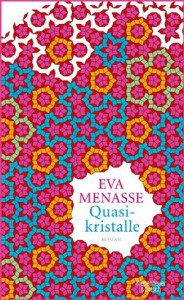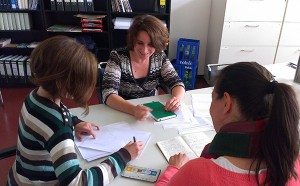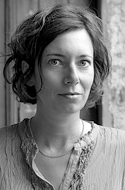A Talk about Jewish Questions, the Lives of Women, and Expectations of Literature
 This blog is edited by three women, all of whom are between their mid-30s and 40. They all studied literature, and try to reconcile to one another their commitment to their profession, their interests, and their private lives. At the center of the latest novel by Eva Menasse, Quasikristalle (2013, ‘Quasicrystals’), is Xane Molin, an at first younger, and then progressively older woman trying to square her career with her wish to be there for her children and to live a good life. In each chapter Quasicrystals takes a different look at her life – and we take different looks at the novel in our discussion here.
This blog is edited by three women, all of whom are between their mid-30s and 40. They all studied literature, and try to reconcile to one another their commitment to their profession, their interests, and their private lives. At the center of the latest novel by Eva Menasse, Quasikristalle (2013, ‘Quasicrystals’), is Xane Molin, an at first younger, and then progressively older woman trying to square her career with her wish to be there for her children and to live a good life. In each chapter Quasicrystals takes a different look at her life – and we take different looks at the novel in our discussion here.
Mirjam Bitter: Since in German substantives referring to persons are not gender-neutral, I re-named our blog’s literature series from the masculine “junge jüdische Autoren”, in more gender-neutral German, to “junge jüdische Autorinnen und Autoren,” that is, “young Jewish women and men authors.” In doing that, it occurred to me that, so far, we have only talked about male authors. What do you think about introducing a woman next?
Mirjam Wenzel: I’m reading Quasicrystals at the moment, by Eva Menasse, and I’m curious what you all think about the book.
Naomi Lubrich: Well… Eva Menasse is a hot topic right now, but I don’t know how fruitful it would be to look at the Jewish aspects of Quasicrystals on our blog. In this novel, Judaism is an issue in only a few places, and there, only in reference to overcoming the past. I was surprised that the novel doesn’t feature a living Judaism, in the sense of portraying a modern congregation or the celebration of holy days. Do you think that this accurately reflects today’s way of life in German-European Judaism?
Mirjam Bitter: I don’t think we have to read the novel as a paradigm for the Jewish life in German-speaking Europe. The main character Xane’s Jewishness is just one of many traits addressed by the novel. It appears that for her, the question of her Jewish identity is most of all connected to the persecution in her father’s past. That she “was henceforth considered a ‘Jewish intellectual’” on account of her investigation of her father’s history of persecution has to do with the perception of others, at that point in the novel.
At the same time, the novel is critical of a constant emphasis on dead Jews, when a hell-bent devotion to the past blinds people to the present: “What a loss the beautiful, educated, dead Jews are! Next to them, the living are a tedious bunch.” The book is inconsistent in this respect, paying scant attention to the myriad ways to be Jewish in today’s world. The book isn’t uninteresting from a Jewish perspective, however, and it also has some literary qualities. Eva Menasse is a perfect master of the short story form (as she demonstrated with her 2009 volume Lässliche Todsünde, ‘Venial Sins’) and here as well I found some chapters extremely successful. At times I could hardly put the book down.
Mirjam Wenzel: I can understand your criticism but at the same time I disagree: the subject of Jewish identity is actually dealt with, in particular in the second chapter – the group tour of the concentration and death camp at Auschwitz. So with reference – at once concrete and over-determinate – to the iconic location of annihilation. In this chapter, where the narrator (Bernays) declares himself as well as the main character to be a “classical case of a half-Jewish double helix”, the absent mistress Pauline also plays a central role. She appears to find Jewish congregational life quite convenient – at least, her daughter’s Bat Mitzvah is coming up. The more attracted Bernays is to Xane, the more often Pauline calls on the telephone – albeit without getting a hearing. In this sense, the novel reflects explicitly how this entanglement in the double helix is a way that the narrator avoids depicting decidedly Jewish ways of life.
All the Jewish characters portrayed in the second chapter are people whose biographies were imprinted essentially by Auschwitz. I find this to be congenial for the portrait that Eva Manasse is drawing – of native-speaking German Jews and not of Jews who happen to be in Germany and Austria. Her diagnosis thus applies to an ever-smaller circle of people within today’s Jewish communities, whose structures, development, and idiosyncrasies would otherwise go unnoticed. In contrast to you all, I like that the novel doesn’t try to represent the diversity of Jewish everyday life only because its central point of reference is a woman with a Jewish father. The book in fact evades en passant conceptual terms like ‘Jewish literature’ along with the expectations that come with it.
Naomi Lubrich: If I extrapolate your thoughts on the ‘over-determinate reference’ of the characters to Auschwitz, I don’t interpret the implications for the process of overcoming the past as only pessimistic. All the same, the examination of their Jewish identity propels both Xane and Bernays toward professional fulfillment – Xane with her political art and Bernays in academic research. It becomes the vital engine of a corresponding social discourse. Art and academia develop for both characters into a kind of makeshift congregation, with a conciliatory effect. This concept makes the book actually seem richer.
So who would like to write the review?
Mirjam Wenzel: I have to go to my next meeting. I suggest that we all think about whether we’re interested and then come to an agreement next time we meet, okay?
Eva Menasse, Quasikristalle, Cologne: Kiepenheuer & Witsch 2013.

